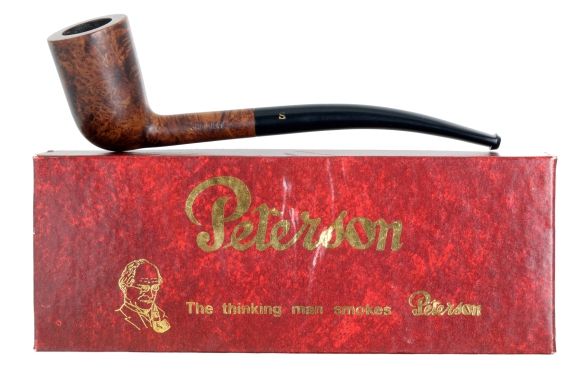109. The 124: A Short History of a Small Pencil-Shank Shape
 This is the short story of a small, pencil-shanked shape that’s peculiarly Irish yet rarely seen, even in the Peterson catalog. The shape’s name seems to depend on what type of stem is attached to the end of the bowl—zulu, churchwarden or dublin.
This is the short story of a small, pencil-shanked shape that’s peculiarly Irish yet rarely seen, even in the Peterson catalog. The shape’s name seems to depend on what type of stem is attached to the end of the bowl—zulu, churchwarden or dublin.
After World War II, or “The Emergency” as it was known in Ireland, Peterson re-established their trade ties and, like other pipe-makers, found the demand for their pipes even greater than it had been seven years before. At some level of consciousness in the Irish spirit there was a nostalgia for something older and more secure, something that spoke of home, stillness, and rest.
Charles Peterson’s favorite Oversize house pipes, with their 7 and 12-inch mouthpieces, were a thing of distant memory. The smaller-bowled straight “reading pipes” of the Patent Era, which also symbolized a leisurely evening’s smoke at home, were also forgotten. But the ache for what they represented must have returned, eventuating in Peterson’s first batch of Specialty Briars “church wardens,” illustrated in the 1945 catalog and 1947 shape chart with the iconic 124, which Peterson dubbed a “dublin.”
The 124 disappeared from the company’s literature for 20 years, until the mid-1960s, when it reappeared with a 6.25-inch mouthpiece and 1/8th bend, making it (at least technically) a zulu shape. It’s interesting that it reappeared at a time of great social unrest, a time characterized in part by a renewed interested in the mythological, the spiritual and the mythopoeic: hashtag Joseph Campbell, Martin Luther King, J. R. R. Tolkien.
1983 Rustic Churchwarden 124
Following a now-familiar pattern, the 124 again disappeared for another twenty years. It resurfaced in 1983’s catalog as a churchwarden. While it was not listed in the Classic Range chart from the same catalog, it made an appearance in the Shamrock line, as documented in the beautiful pipe, box, and papers that came across my desk not long ago.
 What made the particular 124 seen above so much easier to date was the matching box and “Chat with a Smoker” brochure, which can be dated to 1983 according to p. 359 of The Peterson Pipe: The Story of Kapp & Peterson. [Yup, the book’s done and at the printer’s.]
What made the particular 124 seen above so much easier to date was the matching box and “Chat with a Smoker” brochure, which can be dated to 1983 according to p. 359 of The Peterson Pipe: The Story of Kapp & Peterson. [Yup, the book’s done and at the printer’s.]
 For those interested in such plumbing devices, it is interesting to document that this 1983 pipe had a “stinger,” a pointed, aluminum tube that easily slides in and out and seems to have been extensively used by generations of pipemen before mine, then promptly forgot. (If you have experience using such devices, what’s your experience with them?)
For those interested in such plumbing devices, it is interesting to document that this 1983 pipe had a “stinger,” a pointed, aluminum tube that easily slides in and out and seems to have been extensively used by generations of pipemen before mine, then promptly forgot. (If you have experience using such devices, what’s your experience with them?)
 A little over a decade later, the shape made another “nostalgia” appearance in the 1996 Old English Collection, Peterson’s most elaborate set in the Dublin Era (1991–2018), albeit with a shorter and not (to my mind) quite so compelling mouthpiece. I haven’t a clue as to what the shape name might be here: “pencil-shank dublin”? The bowl has a slight cone, which makes “dublin” seem correct. But the stem is also slightly bent, and the overall effect just isn’t stout enough in my mind to qualify it for dublin status.
A little over a decade later, the shape made another “nostalgia” appearance in the 1996 Old English Collection, Peterson’s most elaborate set in the Dublin Era (1991–2018), albeit with a shorter and not (to my mind) quite so compelling mouthpiece. I haven’t a clue as to what the shape name might be here: “pencil-shank dublin”? The bowl has a slight cone, which makes “dublin” seem correct. But the stem is also slightly bent, and the overall effect just isn’t stout enough in my mind to qualify it for dublin status.
And that’s the end of the story, at least as far as the pencil-shank version of the 124 goes. The shape was re-frased (reshaped) with a thicker shank and a different bend (again, I have no idea what the shape name might be) for the Outdoor Sportsman line of nose-warmer shapes in 2011. It has afterwards appeared in a number of lines: the Craftsman Series for January 2016, the churchwarden line (of course), the 2016 Short Classics, and doubtless a few others.
1983 Shamrock 124 Measurements:
Length: 6.25 in. / 158.75 mm.
Weight: 0.90 oz. / 25 gr.
Bowl Height: 1.92 in. / 48.80 mm.
Chamber Depth: 1.62 in. / 41.33 mm.
Chamber Diameter: 0.71 in. / 18.05 mm.
Outside Diameter: 1.18 in./ 30.00 mm.
2018 Outdoor Natural 124 Measurements:
Length: 4.51 in. / 114.55 mm.
Weight: 0.80 oz. / 22.68 g.
Bowl Height: 1.90 in. / 48.26 mm.
Chamber Depth: 1.63 in. / 41.40 mm.
Chamber Diameter: 0.75 in. / 19.05 mm.
Outside Diameter: 1.13 in. / 28.70 mm.
 Tin Talk #8: Paradigm Shift (“Fight the Good Fight”)
Tin Talk #8: Paradigm Shift (“Fight the Good Fight”)




